由煅烧的蒙脱石粘土和石灰石系统的迁移和扩散试验得出的氯化物进入参数
IF 13.1
1区 工程技术
Q1 CONSTRUCTION & BUILDING TECHNOLOGY
引用次数: 0
摘要
用含有硅酸盐水泥、煅烧的蒙脱粘土和石灰石的三元粘结剂制成的水泥浆体经受了氯化物的迁移和扩散。通过压汞孔隙法和扫描电镜背散射电子图像分析研究了氯离子的微观结构变化,通过氯离子结合等温线、热重分析、x射线衍射和扫描电镜能谱分析研究了氯离子的化学变化。以氯离子结合参数作为氯离子扩散模型的输入,对扩散实验中得到的氯离子分布曲线进行处理。在运移过程中,观察到纯硅酸盐水泥样品的孔隙结构有所细化。在扩散中没有观察到变化,三元共混物也没有。此外,与波特兰水泥相比,三元共混物导致更多的氯化物结合,主要是由于更多的弗里德尔盐。从迁移和扩散实验中得到的与输运性质完全相关的有效扩散系数符合得很好。相反,表观扩散系数可能相差2倍。讨论了有关氯化物进入的含义。本文章由计算机程序翻译,如有差异,请以英文原文为准。
Chloride ingress parameters derived from migration and diffusion tests for systems with calcined smectitic clay and limestone
Cement pastes made with ternary binders containing Portland cement, calcined smectitic clay and limestone were subjected to chloride migration and diffusion. Microstructural changes due to chloride ingress were studied by mercury intrusion porosimetry and SEM back-scattered electron image analysis, while chemical changes were investigated via chloride binding isotherms complemented by thermogravimetric analysis, X-ray diffraction and SEM-EDS. Chloride binding parameters were taken as inputs in a chloride diffusion model, to process chloride profiles obtained in diffusion experiments.
Refinement of the pore structure was observed for pure Portland cement samples in migration. No changes were observed in diffusion, nor with ternary blends. Moreover, ternary blends lead to more chloride binding compared to Portland cement, mainly due to more Friedel's salt. Effective diffusion coefficients, purely linked to transport properties, obtained from migration and diffusion experiments agree well. Conversely, apparent diffusion coefficients may differ by a factor two. Implications regarding chloride ingress are discussed.
求助全文
通过发布文献求助,成功后即可免费获取论文全文。
去求助
来源期刊

Cement and Concrete Research
工程技术-材料科学:综合
CiteScore
20.90
自引率
12.30%
发文量
318
审稿时长
53 days
期刊介绍:
Cement and Concrete Research is dedicated to publishing top-notch research on the materials science and engineering of cement, cement composites, mortars, concrete, and related materials incorporating cement or other mineral binders. The journal prioritizes reporting significant findings in research on the properties and performance of cementitious materials. It also covers novel experimental techniques, the latest analytical and modeling methods, examination and diagnosis of actual cement and concrete structures, and the exploration of potential improvements in materials.
 求助内容:
求助内容: 应助结果提醒方式:
应助结果提醒方式:


